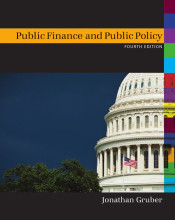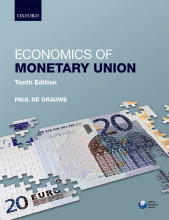Summary: Public Finance And Public Policy | 9781464142246 | Jonathan Gruber
- This + 400k other summaries
- A unique study and practice tool
- Never study anything twice again
- Get the grades you hope for
- 100% sure, 100% understanding
Read the summary and the most important questions on Public Finance and Public Policy | 9781464142246 | Jonathan Gruber
-
11 Education
This is a preview. There are 13 more flashcards available for chapter 11
Show more cards here -
Why should the government involve in education?
Productivity society can benefit from the higher standard of living that comes with increased productivity
Citizenship education may make citizens more informed and active voters, improving the quality of the democratic process -
Which failures motivate government intervention in education?
Educational credit market failure: credit market cannot offer loans since there is no collateral
Failure to maximize family utility parents do not choose appropriate level of education for children
Redistribution educ is a normal good, high income families provide more educ. Income mobility! -
How may public education crowd out private education provision? Peltzman model (1973)
Absent free public schools, some parents would send their children to expensive, high-quality schools. With free public schools, parents can reduce quality by a small amount but save a lot. -
What is the main solution to the crowd-out problem?
Educational vouchers: a fixed amount of money given by the government to families with school-age children, who can spend it at any type of school, public or private. It puts private schools and public schools on equal footing. -
What are two arguments for educational vouchers?
Consumer sovereignty: vouchers allow individuals to more closely match their educational choices with their tastes
Competition: vouchers allow the education market to benefit from the competitive pressures that make private markets function efficiently. -
What are arguments against vouchers?
Excess specialization by focusing on particular market segments, schools give less focus to the key elements of education
Seggregation vouchers have the potential to reintroduce segregation along many dimensions, such as race, income, or child ability
Inefficient use of public resources families would send their kids to private schools and pay for it anyway
Education market may not be competitive more closely to a natural monopoly, with efficiency gains to having one monopoly provider of the good
Costs of special education students with disabilities cost about twice as much as students without -
What do empirics say on vouchers?
Rouse (1998): vouchers increased test scores by 1-2 percentage points
Angrist (2002): Columbian vouchers distributed by lottery. Vouchers winners 10% more likely to finish 8th grade. -
The US has implementedmany programs making schools accountable for student performance. Accountability encourages schools to increase quality. What unintended effects do accountability programs have?
1 they encourage teaching to the test
2 schools can manipulate the pool of test takers and the conditions under which they take tests to maximize success
3 they may encourage schools or teachers to cheat -
Bottom line on vouchers and school choice?
Evidence is mixed, but generally suggests that vouchers improve educational outcomes. This comes at the cost of potentially increasing inequality in educational achievement. Some sort of guarantee of access must be provided to ensure all students have an education. -
What are returns to education? More education clearly leads to higher wages. Why is the interpretation of this correlation controversial?
RtE: the benefits that accrue to society when students get more schooling or when they get schooling from a higher quality environment.
Controversial: Two interpretations: Education as human capital accumulation or screening (only a means of separating high- from low-ability individuals and does not actually improve skills).
- Higher grades + faster learning
- Never study anything twice
- 100% sure, 100% understanding

































